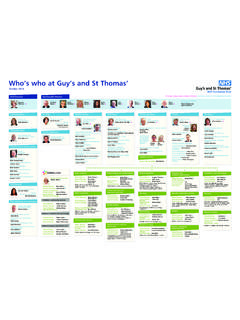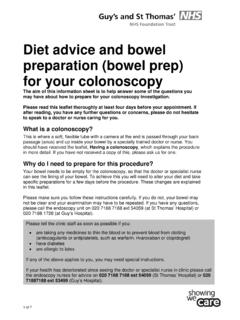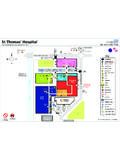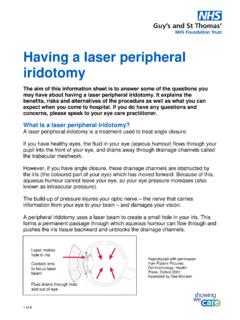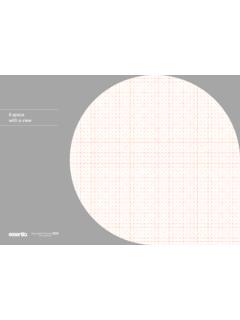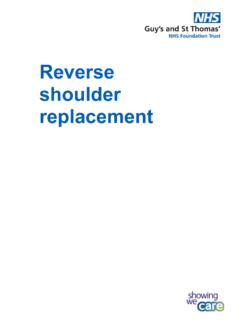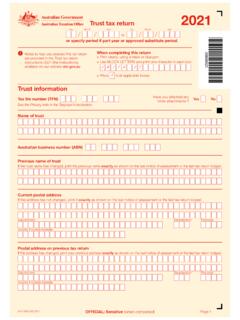Transcription of Hormone replacement therapy (HRT) - Guy's and St …
1 1 of 5 Hormone replacement therapy (HRT) The leaflet aims to answer your questions about taking HRT to treat your menopausal symptoms. If you have any questions or concerns, please speak to the doctor or nurse caring for you. This leaflet should be read alongside any patient information provided by the manufacturer. What is HRT and why do I need it? HRT is medication aimed at relieving the symptoms that some women experience during the menopause, also known as the change of life. These symptoms could include hot flushes, night sweats, vaginal dryness, tiredness and irritability, and decreased sex drive. HRT works by replacing the Hormone (oestrogen) that your body stops producing when you go through the menopause or when you have had surgery to remove your ovaries.
2 Used long-term, HRT may help to reduce the risk of osteoporosis (thinning of the bones) and bowel cancer. However, there are also known risks including an increased risk of certain types of cancer. These risks are described in more detail later in this leaflet. As new research is available this will be discussed with you in your clinic appointment. When you start HRT, the doctor or nurse will discuss your age, symptoms and medical conditions before looking at the risks and benefits of HRT which are specific to you. These risks and benefits could change and will be discussed at your yearly review. Some women have a medical menopause (a menopause caused by medical treatment) and may be offered HRT.
3 Some women are not able to take HRT usually these are women with cancers that have been caused by hormones and women who have had a blood clot. You may have heard of bioidentical hormones. These are not used in treatment as they have not been approved by organisations that regulate medicines. They have not been researched and proved safe to use. What are the different types of HRT? There are two different types of HRT. The type of HRT you take will depend on where you are in the menopause and if your periods have stopped completely for a year. Oestrogen only (no progestogen) this is for women who have had a hysterectomy (surgery to remove their womb), or are using an intrauterine system (IUS) such as Mirena.
4 This type of HRT does not contain progestogen to protect the lining of the womb. Combined HRT (oestrogen and progestogen) this is necessary if you still have your womb. This can be given in two ways. o Continuous combined HRT oestrogen and progesterone, taken together daily (one a day) for 28 days. This means that there will be no withdrawal bleeds. o Sequential HRT oestrogen only for the first 14 days then both hormones for the second 14 days. This usually results in monthly withdrawal bleeds. 2 of 5 How much will HRT cost? HRT is only available on prescription and will be charged at the current prescription rate.
5 Sometimes your HRT will involve two medicines and you may need to pay for two prescriptions. How long does HRT take to work? It usually takes a few weeks before you will feel the initial benefits of HRT and up to three months to feel the full effects. It may also take your body time to get used to HRT. When treatment begins you may experience side effects such as breast tenderness, nausea and leg cramps. Usually these side effects will disappear within six to eight weeks. If they do not, a change in the type or dose of HRT may be necessary and your doctor or nurse will advise you on this. If after four to six months of HRT you have not felt the benefits of the HRT it may help to try a different type.
6 How do I take the medicine? This depends on the type of HRT you are taking (oestrogen only or combined) and does not always mean tablets. Below is an overview of the different types, or preparations , available. Patches HRT patches can contain oestrogen, alone or with progestogen. They are applied once or twice a week to any area below the waist. They are effective in relieving both short-term symptoms and, if taken for longer, the long-term complications of the menopause. HRT tablets A wide range of tablets are available, and they are taken once a day. They can contain oestrogen or a combination of oestrogen and progesterone.
7 They are effective in relieving both short-term symptoms and, if taken for longer, the long-term complications of the menopause. HRT gel Oestrogen is also available in the form of a gel. It is applied once a day to a clean, dry, unbroken area of skin, usually on the upper arm, shoulder or inner thigh. It is rubbed in and takes a few minutes to dry. The gel is clear and non-greasy. If you have a womb then you will also need to have progesterone to protect the womb lining. This can be in the form of either tablets or Intra Uterine System (IUS) Mirena (there is a separate leaflet about IUS, please ask if you would like a copy).
8 Vaginal oestrogen (local HRT) Vaginal creams, vaginal tablets, vaginal rings or vaginal pessaries contain a small amount of oestrogen and only work for specific symptoms where they are applied, such as vaginal dryness and urinary symptoms. Local HRT will not improve other symptoms, such as hot flushes, or protect against the longer term effects of the menopause such as osteoporosis. Local HRT does not have the same increased risks as other types of HRT so can be used by most women (see below for more information about risks). What should I do if I forget to take the medicine? If you forget to take your HRT do not take the doses that you have forgotten, just take the next dose when you remember.
9 3 of 5 Are there any side effects? Many women experience side effects in the first few months of taking HRT. If problems persist after three months of treatment then the type of HRT may be changed. Women react differently to HRT, so there is no one preparation that is better than any of the others. It is often a personal choice as to the type of preparation we try first. Weight gain It has been scientifically proven that women gain weight during the menopause, so any weight gain may not be a result of HRT. Your body s fat distribution also changes, with an increase in fat around the waist and less around the hips and buttocks.
10 You can also experience water retention when on HRT. If this happens then it may be worth trying a different preparation of HRT. Blood pressure There is no evidence that blood pressure increases with taking HRT in most women. Women are advised to have their blood pressure checked and treated in the usual way. Bleeding Irregular bleeding in the first few months of taking any form of HRT is quite common and usually settles. Any bleeding after the first six months will need to be investigated with ultrasound scans and possibly a hysteroscopy (where we look inside the womb, through the vagina, using a small telescope at the end of a narrow tube).
